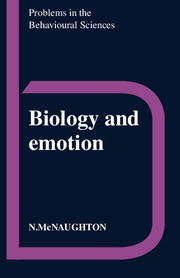Book contents
- Frontmatter
- Contents
- Preface
- Acknowledgements
- 1 Emotion since Darwin
- 2 Releasers and state-dependent reflexes
- 3 Purpose and emotion
- 4 Expression: a window on the emotions?
- 5 Are physiological changes epiphenomena of emotion?
- 6 Somatic influences on the emotions
- 7 Optimal foraging and the partial reinforcement effect: a model for the teleonomy of feelings?
- 8 Do emotions mature or differentiate?
- 9 Cognition, learning and emotion
- 10 Interaction of the components of emotion
- 11 Of mice and men
- 12 Biology and emotion: some conclusions
- Glossary
- Notes
- References
- Index
10 - Interaction of the components of emotion
Published online by Cambridge University Press: 05 August 2012
- Frontmatter
- Contents
- Preface
- Acknowledgements
- 1 Emotion since Darwin
- 2 Releasers and state-dependent reflexes
- 3 Purpose and emotion
- 4 Expression: a window on the emotions?
- 5 Are physiological changes epiphenomena of emotion?
- 6 Somatic influences on the emotions
- 7 Optimal foraging and the partial reinforcement effect: a model for the teleonomy of feelings?
- 8 Do emotions mature or differentiate?
- 9 Cognition, learning and emotion
- 10 Interaction of the components of emotion
- 11 Of mice and men
- 12 Biology and emotion: some conclusions
- Glossary
- Notes
- References
- Index
Summary
We feel, conceive or reason, laugh or weep;
Embrace fond woe, or cast our cares away:
It is the same! – For, be it joy or sorrow,
The path of its departure still is free;
Man's yesterday may ne'er be like his morrow:
Nought may endure but Mutability.
Percy Bysshe Shelley: MutabilityDialectical and non-dialectical interactions in emotion
The previous chapters have, as far as possible, treated the various components of emotion in isolation. One reason for doing this has been simplicity. However, a more important reason has been that, given the likely evolution of emotional systems (Chapters 2, 3), there is no guarantee that the individual ‘components of emotion’ do not have entirely separate control systems from each other. Such separation would not require us to give up emotion as a concept, since teleonomy alone could provide a conceptual link between different components. However, the normal use of the word emotion implies some direct connection between the different components. This chapter, therefore, considers interactions between those aspects of emotion which have been separated by the previous chapters. Throughout, it should be borne in mind that the usual co-occurrence of such components is no justification for treating them as linked. As a corollary to this it should also be remembered that mechanistic links between components of one emotion do not imply mechanistic links between the same components of some other emotion.
- Type
- Chapter
- Information
- Biology and Emotion , pp. 130 - 142Publisher: Cambridge University PressPrint publication year: 1989

